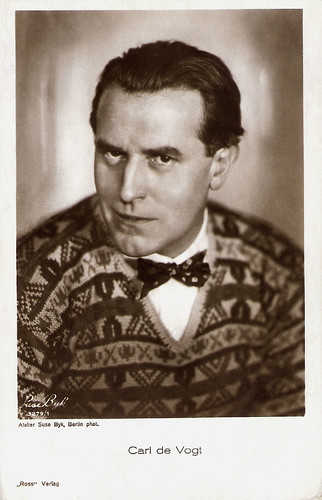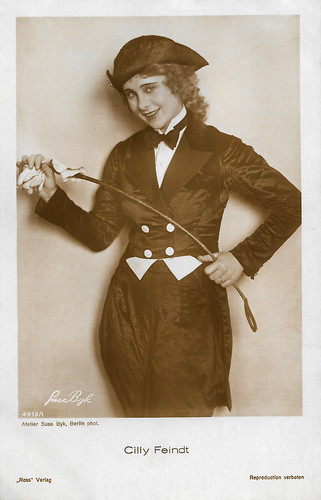
German postcard by Ross Verlag, Berlin, no. 1973/1, 1927-1928. Photo: Suse Byk, Berlin.
Colette Brettel (1902-1973) was a British actress who appeared in several British films of the early 1920s. From 1923 until the introduction of sound, Brettel had a fruitful career in Germany, being directed by a wide range of directors such as Manfred Noa, Hans Steinhoff, and Fred Sauer.

German postcard by Verlag Musikhaus Päsold, Berlin Charlottenburg, no. 1396. Photo: Suse Byk. Lotte Schöne in the opera 'Ein Maskenball' (Un ballo in maschera) by Giuseppe Verdi (1859). Schöne played the page Oscar, a role traditionally sung by a soprano.
Lotte Schöne (1893-1977) was an Austrian opera and lieder singer. She was one of the great German-speaking opera stars in the first half of the twentieth century. She celebrated her greatest triumphs in the period after the First World War until the National Socialists came to power. During this period Lotte Schöne sang mainly in Vienna and Berlin, but also at the Salzburg Festival and in numerous guest performances abroad.

German postcard by Ross Verlag, no. 3028/1, 1928-1929. Photo: Suse Byk, Berlin.
German character actor Kurt Vespermann (1887-1957) was active in nearly 200 films between 1915 and 1957.

German postcard by Ross Verlag, no. 3200/1, 1928-1929. Photo: Suse Byk, Berlin.
Jaro Fürth (1871-1945) was an Austrian stage and film actor. He acted in many silent German films of the 1920s including some masterpieces by F.W. Murnau and G.W. Pabst.
A master photographer
Suse Byk was born Susanne 'Suse' Sarah Wally Byk in 1884 in Berlin. As for many other photographers of her time, her life could only be reconstructed in fragments. This also applies to her photographic work, which has not been preserved in one or more convolutions, but only individual pieces can be found in various books, collections and archives.
Her parents were Dr Siegmund Byk, a chemist and factory owner with a doctorate, and his wife Clara. Clara Byk was a cousin of her husband; she wrote a family history and died in Berlin in 1926. Dr Siegmund Byk retired from the board of Chemische Fabrik Byk, founded in 1873, in 1905.
Suse Byk served an apprenticeship as a photographer which she completed at the Lette School. In 1910 she was admitted to the Photographischer Verein zu Berlin. There is evidence of a photo studio under her name for the first time in 1911 at her father's private address at Kurfürstendamm 14/15 on the III floor. Later she took over Ernst Sandau's studio.
In 1913 she took part in the first "Conference for German Women Photographers" in the rooms of the Berlin Women's Club, at which time she was called "a master photographer". In 1919, she opened a "studio for photographic portraits" under her name at Kurfürstendamm 230, which she ran until 1938.
Her father, Siegmund Byk, supported her in the management as an authorised signatory. The photographers Martha Maas and Lore Feininger began their apprenticeships as photographers with Byk in 1916 and 1919 respectively. By 1929, Suse Byk employed five people.

German postcard by Ross Verlag, Berlin, no. 3199/1, 1928-1929. Photo: Suse Byk, Berlin.
Colette Brettel (1902-1973) was a British actress on the silent screen. In 1923 she went to Germany, where she appeared in several silent films and met her future husband, the Dutch actor and director Ernst Winar.

German postcard by Ross Verlag, no. 3279/1, 1928-1929. Photo: Suse Byk, Berlin.
German actor Carl de Vogt (1885-1970) was a kind of Indiana Jones in the silent films of Fritz Lang. De Vogt was also a popular singer and made several records in the 1920s.

German postcard by Ross Verlag, no. 3317/1, 1928-1929. Photo: Suse Byk, Berlin.
German actress Evi Eva (1899-1985) was a popular star of the silent cinema. Later, the once-famous actress lived in very poor conditions.

German postcard by Ross Verlag. no. 3625/2, 1928-1929. Photo: Atelier Suse Byk, Berlin.
German actress Hanni Weisse (1892-1967) belonged to the great film divas of the early German silent film. She was able to maintain her stardom till the 1920s.
Work under conditions of anti-Semitism
Suse Byk's studio (in German: Atelier Suse Byk) photographed a number of female artists, artists and scientists (including Albert Einstein) in Berlin in the 1920s. Byk also had commissions to shoot fashion for illustrated magazines in the 1920s and she worked as a theatre photographer for the artists of the Städtische Oper. In 1926 she expanded her company name to include "family and film photography", and from 1924 she also shot films of children and animals for private clients.
In 1925 she made role portraits and film recordings of the modern dancer and pantomime Valeska Gert. In addition to role portraits of Georg Groke as Kastschej in 'Feuervogel' and of Rudolf von Laban and his troupe, dance photographs of Niddy Impekoven, Gret Palucca, Hertha Feist, Lizzi Maudrik and her dance troupe Maudrik, Vera Skoronel and the Skoronel-Trümpy group, among others, have survived. In 1927, she took a photograph of Judith Kerr and her brother Michael Kerr in her studio.
In January 1927, she married the journalist and writer Hellmuth Falkenfeld. Byk and her husband remained in Berlin after the transfer of power to the Nazis in 1933 and continued to work under conditions of anti-Semitism, although her work did not initially seem to be directly affected by the state measures, as a work of hers was published as late as 1935. Under political pressure to emigrate, she gave up in 1938 and attempted to sell her business.
Liselotte Strelow had learned in Byk's business and she then worked at Kodak in Berlin. Strelow took over the business and flat in 1938 for the Aryanisation price of RM 2,500, half the sum demanded by Byk, and opened the studio on 1 October 1938, which she continued under the established name. In July 1939, the Byk company was deleted from the commercial register. The studio and Byk's photographic archive, which may have been in it, were destroyed in the air war.
In 1938, Suse and Hellmuth Falkenfeld emigrated to London and from there to New York. Nothing is known about the last years of Suse Falkenfeld-Byk's life. She died in 1943 in Manhattan, New York City.

German postcard by Ross Verlag, no. 3627/1, 1928-1929. Photo: Atelier Suse Byk, Berlin.
Dita Parlo (1908-1971) was a popular European film star in the late 1920s and early 1930s. She inspired both Dita Von Teese and Madonna, who used Parlo's name & character from L'Atalante (1934) for her controversial 'Sex' book and 'Erotica' album.

German postcard by Ross Verlag, no. 4410/1, 1929-1930. Photo: Suse Byk, Berlin.
Handsome and dashing Hans Brausewetter (1899-1945) was a supporting actor in the silent German cinema. From 1922 on, he appeared in 135 films. In one of the last days of the war, Brausewetter was killed by the blast of a bomb in Berlin.

German postcard by Ross Verlag, Berlin, no. 4913/1, 1929-1930. Photo: Atelier Suse Byk, Berlin.
The tiny, dainty blonde Cilly Feindt (1909-1999) was a German star of the circus ring. In her heyday, she was regarded as one of the finest haute ecole horse riders of her time.

German postcard by Ross Verlag, no. 8537/1, 1933-1934. Photo: Suse Byk, Berlin.
For a brief period during the Weimar Republic, Hertha Thiele (1908-1984) appeared in several controversial stage plays and films. She is best known for playing a 14-year-old schoolgirl in love with her female teacher in the ground-breaking Mädchen in Uniform/Girls in Uniform (1931). She received thousands of fan letters - mostly from women. Decades later, Thiele became a well-known film and television actress in East Germany.
Source: Wikipedia (German and Italian) and Deutsche Fotothek.
No comments:
Post a Comment